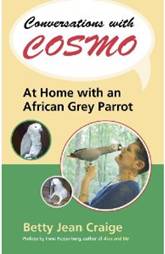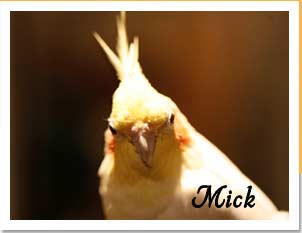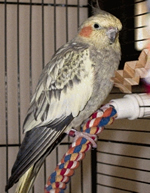Birdie Bookshelf:
The Lives and Minds of “Bird People” — Part II
By Jonathan Harris
 Betty Jean Craige. Conversations with Cosmo: At Home with an African Grey Parrot. Santa Fe, NM, Sherman Asher, 2010. Preface by Irene Pepperberg. 194 pp. Photographs and index. $19.95 Hardcover. ISBN 13: 978-1890932-374-1
Betty Jean Craige. Conversations with Cosmo: At Home with an African Grey Parrot. Santa Fe, NM, Sherman Asher, 2010. Preface by Irene Pepperberg. 194 pp. Photographs and index. $19.95 Hardcover. ISBN 13: 978-1890932-374-1
This is the much-delayed companion review to Irene Pepperberg’s Alex & Me, which appeared in Mickaboo’s January 2011 newsletter. My somewhat whimsical title, “The Lives and Minds of ‘Bird People’,” was meant to connect the human companions (scientists and others) studying African Grey parrots and the birds themselves, whose intelligence was so well recognized even in the 19th century that some naturalists referred to them as “bird men.” (In one interview, Pepperberg called Alex a “colleague.”) Pepperberg’s memoir makes a compelling case for Alex’s personhood, I concluded, though that is a characterization she or any scientist might fairly protest. Science deals with what is observable and testable, after all, not in fuzzy philosophical concepts.
That notion is less problematic for Betty Jean Craige, who simply leaps with profound faith across the doubts science will not tread. She has written a short and deceptively simple account of her daily life with Cosmo, a 10-year-old (female) African Grey parrot she bought at a pet store in 2002. Conversations with Cosmo is at once an autobiography, memoir and meditation on non-human minds, a practical guide to bird care, and a 10-year case study in the development of verbal communication abilities and the mental life of an African Grey.
Cosmo makes a worthy and fascinating companion to Alex, and not just because both books describe experiences with birds of the same species; each is fundamentally, seriously concerned with mind and communication, one by a scientist who studied the bird rigorously for 30 years, the other by an ordinary and relatively new bird companion (owner, guardian, person, servant,…), an amateur in the truest sense.
But do not be misled either by Craige’s amateur status or her chatty tone. Underneath is a serious agenda of introducing a humanistic and holistic perspective into a field of study traditionally dominated by methods and concepts that are analytic and reductive. There is a point beyond which science cannot go in the analysis of intelligent, purposeful behavior, even with animals. Some things cannot be proven or even tested easily, and a humane interpretation like Craige’s may provide our best entry into animal minds.
Craige is recently retired, but when she wrote Cosmo, she was a named professor and chair of the Comparative Literature department at the University of Georgia, Athens. So her intellectual credentials were sound, though not in neurobiology, ornithology or psychology. She is no Aniruddh Patel or Irene Pepperberg; she is a humanist—but a humanist who has been explicitly concerned with the practical use of language. In addition, Craige has been interested in ecology; she has taught and written about ecological thought, including notably a biography of her friend the pioneer American ecologist Eugene Odum. She has liked animals all her life and had several dogs before getting Cosmo. Her decision to get a parrot was the extension and pursuit of a long-standing interest in language acquisition by non-human animals: she had read about Koko the gorilla, Lana the chimp, Akeakamai the dolphin, and of course Alex. She wanted to know, following the path of linguistic anthropologists like B.L. Whorf, how having language might influence an animal’s worldview and perhaps its ability to live in a humanized world.
Much of this book is concerned with how Cosmo acquires and uses language. Cosmo has not shown an interest in learning abstract qualities such as number or color, the way Alex did, but her practical grasp and mental acuity in acquiring and using language are impressive.
Like many Greys, during her first year Cosmo obviously listened a great deal but said nothing. She wolf-whistled sometimes and imitated sounds, such as the smoke alarm that went off once when the author was frying chili peppers. Craige talked (and talks) to Cosmo much as Pepperberg did to Alex. Especially when she was young, this was as a loving parent talks to an intelligent, curious toddler. Craige followed Pepperberg’s model and continues to use a limited vocabulary and simplified speech, but her tone is natural, affectionate, and almost unthinking.
Cosmo first imitated sounds and made associations. She learned simple phrases (“Cosmo is a good bird”) then extracted labels from those phrases (“Cosmo,” “bird”), the words for things and actions, and like Alex began inflecting and extending them in creative ways. What is impressive, Craige says, and still more fundamental is that Cosmo apparently learned the broader concept that everything in the world has a name. This represents a significant conceptual leap which gives Cosmo a way of living in the human world and Craige a way of seeing the world through Cosmo’s eyes.
With about 20 basic phrases, Cosmo can ask for and about things and express feelings. She has recognized, learned, and/or developed on her own a surprising number of what might be called elements or aspects of language. She has learned to express past and future as well as present actions. She understands interrogative inflections and correctly uses the pronouns “I, you, we,” as well as the conjunction “and.” She can express negation (“no, don’t”). She has developed a descriptive imperative (“Time to go to bed”) and anticipatory future (“We're gonna have company!”). She both asks and answers “What’s that?” questions.
Cosmo forms categories in human-like ways; she recognizes her natural affinity with other birds and extends the meaning of certain words and categories by analogy. She has feathers, birds have feathers, dogs have fur. Betty Jean has clothes.
Beneath the acquisition and use of language, Craige wants to understand Cosmo’s consciousness—what she really perceives, how she thinks and feels, what her interior life must be like. Following Pepperberg, she sees in Cosmo something like the mind of a young child. But in wondering about Cosmo’s actions, she also asks how much they and the thoughts behind them are conditioned by language itself, the language she has imposed, and how much by deeply wired responses of the organism to the natural environment to which it’s adapted. She tries to interpret Cosmo’s behavior both in semi-humanized terms and in terms of what would be meaningful to her as a bird, an African Grey.
By the standards of animal psychologists, Cosmo is pretty clearly a smart creature. She recognizes her image and the images of other birds in the mirror and on the computer screen. Moreover, in seeing and recognizing those images, she sometimes recalls specific incidents in which they or similar individuals were involved. She watches the back yard and comments on the activities of local birds and squirrels.
Cosmo does not seem to have a human-like conscience, but does know what is unacceptable. She is able to name her sins, condemn them when she is busted and even mete out punishment (send herself back to her cage). However, she does express love and concern for others. She can be affectionate; likes to kiss and to be kissed on the feathers, especially after a long separation. She plays with the dogs and thinks about her canine flock mates. When one was hospitalized, she apparently worried about her and verbally expressed her concern, using the only words she could; then she greeted and followed the dog around when she returned home from the vet.
Parrots have long been credited with (accused of) having senses of humor and playing jokes. Cosmo both plays practical jokes (e.g., mimicking sounds to get Betty Jean’s attention) and makes up “verbal” jokes by putting together absurd but plausible word-phrase combinations (imitating the answering machine: “Beep. Hello, Telephone for bird! Hahahahaha….”) and laughing at her own jokes. Craige wonders whether Cosmo really experiences these performances as funny or whether she does them just to get attention. To me, all evidence and reason point to a sense of humor. Cosmo obviously enjoys these verbal absurdities. Sometimes when she thinks no one else is around she recites them to herself and laughs. She loves these as well as cruder practical jokes (imitating the telephone when Betty Jean is in the shower). Primatologists say chimps and other great apes laugh and find humor in their worlds. Why should it not be so for an intelligent, playful “bird primate”?
Cosmo is also a practical book, a book of praxis, in ways Pepperberg’s research and even autobiography do not (maybe cannot) ever achieve. Craige includes an appendix of 44 tips for bird care—African Grey care specifically, but many have broader applicability. While readers no doubt will disagree with some of Craige’s specific ideas, many others will be familiar to Mickaboo volunteers. There’s no question she has the whole of Cosmo’s being as a defining concern in her life right now. And all of her ideas derive from a fundamental “golden rule:” treat a bird with love and respect, give it a lot of stimulation and social interaction.
Craige is concerned with more than Cosmo’s current consciousness; she’s also concerned with her future life and happiness. She has provided for Cosmo in her will and designated the human friends she wants to become Cosmo’s future parronts; moreover, she has taught Cosmo words and phrases that will enable her to communicate her perceptions and needs to future human companions.
The work with Cosmo continues; Craige is retired now and actively continuing her educational and ambassadorial work with Cosmo. She regularly visits classrooms and libraries. She has a weekly column in the Athens Banner Herald and a Facebook page where she reports and reflects on Cosmo’s actions and answers questions from parrot enthusiasts and the public.

